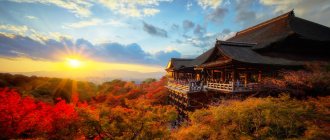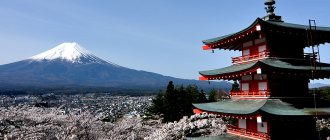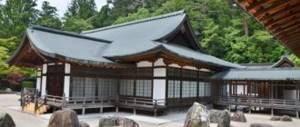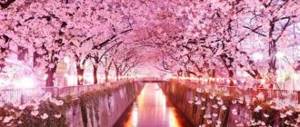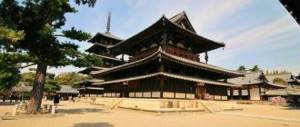In Japan, everything related to the history of the country is treated with trepidation. One such carefully preserved relic is Himeji Castle. In 1993, this architectural monument was included in the World Heritage List compiled by UNESCO.
There are 83 buildings on the castle grounds, most of them were built from wood by ancient Japanese architects. Even tourists who have seen a lot fall in love with the castle at first sight. Let's figure out whether it's worth spending time visiting Himeji Castle if you're lucky enough to find yourself in this unique country.
How to get there on your own
The easiest way to get to Himeji from Tokyo or Osaka is by train. The journey from the Japanese capital will take about four hours. The journey from Osaka is an hour and a half. You need to take a ticket to the city of Himeji. When you get off the platform, you will see the castle immediately - it is impossible not to notice it. From the station to the castle you can walk, the distance is about a kilometer. If a walk is not part of your plans, then take the bus. There is a fee to visit the castle. Cost: $9. We recommend taking a single ticket, it will cost only 50 cents more - it includes not only a tour of the most romantic castle in Japan, but also a walk through the Koko-En landscape garden. It is only a ten minute walk from Himeji.
At the White Heron Castle you will admire the unique wooden carvings made by the hands of ancient Japanese craftsmen. Admire the beauty and grace of the golden sliding partitions, painted with images of flowers and strange birds. Authentic samurai armor is on display in the halls.
Be sure to go up to the top floor of the main tower. There is a shrine there, guarded by the soul of the most famous samurai - Miyamoto Musashi, who wrote a treatise on military strategies.
Price
| Adult ticket (from 18) | 1000 JPY (≈9 USD) |
| Students, schoolchildren | 300 JPY (≈3 USD) |
| Group of adults from 30 people | 800 JPY (≈7 USD) / person |
| Group of students from 30 people | 240 JPY (≈2 USD) / person |
| Adult ticket inclusive of Cocoen Gardens | 1050 JPY (≈ 9.5 USD) |
| Students, schoolchildren visiting the Kokoen garden | 360 JPY (≈3 USD) |
Tickets cannot be purchased in advance. Sold only at the box office and for the current day
History of White Heron Castle
Construction of the complex at the foot of Mount Hime began in the mid-fourteenth century. The castle received its poetic name for the originality of its architecture; from a distance it actually resembles the image of this beautiful elegant bird. Himeji became an example of Japanese architecture, and castles were built in its likeness throughout the country. Carefully whitewashed walls, a reliable high foundation made of stone - these details began to be considered characteristic of fortified structures of the Land of the Rising Sun.
For many years the fortress changed its owners. At the end of the sixteenth century, it passed into the hands of the famous military leader Toyotomi Hideyoshi. By that time, the castle had already begun to collapse, unable to withstand the constant battles. He needed restoration work. Serious reconstruction began. In eight years, from 1601 to 1609, almost all the structures that are now part of the architectural complex of the White Heron Castle were built. Including the seven-tiered main tower, the height of which is impressive - it rises 45 meters above the ground. In addition to the construction of a new defensive complex, the territory adjacent to the castle was redeveloped. By order of Toyotomi, a large garden was laid out, planned in the form of an intricate labyrinth with numerous dead ends.
It was not possible to determine the effectiveness of this idea in combat conditions: in this part of Japan, internecine wars between samurai clans were over. This contributed to the fact that a settlement appeared next to the castle, which received the same name - Himeji.
Other
- Smoking is not allowed in the castle
- There are no trash cans on site
- Pets can only be carried in a carrier/cage. There is free rental of cages in the Administration building
- Drones are prohibited
- You cannot eat or drink inside the castle (except for water in a plastic bottle). It is strictly forbidden to bring alcoholic beverages, your own lunch, canned food, drinks in glass bottles, chewing gum, candy and ice cream.
- You cannot enter the castle again on the same day with the same ticket.
- The nearest parking lot is “Otemon parking” - 10 minutes from the entrance to the park. 3 hours - 600 JPY (≈5.5USD). Other parking lots and their prices can be found on this website.
Two-Faced Janus: Grace and Cunning
At first glance, the castle seems fragile and decorative, unable to withstand the onslaught of the enemy. In fact, he is not at all defenseless; everything about him is thought out to the smallest detail.
The roofs of towers and other buildings are covered with dense wood panels. The seemingly thin snow-white walls are made of durable compressed clay, capable of withstanding direct hits from shells. The fortress is protected from attack by invaders by reliable fortified gates, two defensive lines, and deep ditches. A trap was also set up, disguised as a gate. There are loopholes on the inner and outer walls, from where the defenders of the citadel could conduct aimed fire at the attackers. The main gate through which one can get to the central tower cannot be burned down; this is prevented by an iron edging.
The external fragility of the complex is just another trick. Many tourists are amazed at the discrepancy between the external and internal appearance of the castle. I can’t even believe that I’m getting inside a castle in the air that I just admired from afar. Everything seems ominous. The upper levels are designed like a labyrinth, in which it is impossible not to get lost if you do not know the hidden passages. Stairs are designed in such a way that they change direction all the time.
The fortress has another important advantage - it destroys the psychological balance of enemies. Here you can’t be sure of anything; at every step a new trap awaits the attackers, well-concealed defense mechanisms are triggered.
In case of a long siege, weapons and food warehouses were prepared, and wells were dug.
Story
In the 13th century, samurai Akamatsu Norimura ordered the construction of a fortress on top of Himeyama Hill. A few years later, his relative rebuilt the fort into a palace - Himeji.
During the civil war of the 15th century, Himeji moved from one clan to another. Until in 1600 the castle was donated to Prince (Daimyo) Ikeda Terumasa for the Battle of Sekigahara. It was during his ownership that the main building was completed and other structures were erected, which have remained almost untouched to this day .
After Terumasa, Himeji was controlled by several prominent families, sold at auction, survived the bombing of World War II, was recognized as a UNESCO World Heritage Site, and became a favorite pilgrimage site for millions of tourists.
Please note: the number of visitors to Himeji Castle is limited to 15 thousand/day. Another reason to arrive early.
Himeji Castle in the film industry
The charm of the White Heron Castle has not been lost on cinema - not only Japanese but also Hollywood directors have repeatedly featured it in their films. You might have seen him in Akira Kurasawa's films Shadow of the Warrior (filmed in 1980) and Ran (released in 1985). The events of the film “The Last Samurai” took place here; Tom Cruise starred in it. Another famous film in which you can see Himeji Castle is “You Only Live Twice”, in which, according to the script, there was a secret ninja school.
0 0 votes
Vote for the article!
Himeji inside
It is worth noting that in addition to the vast territory and additional buildings around, Himeji itself has as many as 7 floors! So you won’t be able to see everything quickly. Plan on about 2 hours . And if you are also a photoholic, like me, then as many as 3-4. The castle is simply fabulously beautiful!
Having difficulty tearing ourselves away from the camera, we moved towards the main building. In addition to the white walls, the tiles immediately attract attention - another feature. The joints between round and flat tiles are generously covered with plaster. By local standards, this is very expensive, but what a refreshing effect on gray roofs!
At the entrance you are given slippers and the quest begins! The wooden floors are highly polished and the soles are fantastically slippery. Most likely on purpose, so that it would be inconvenient to run up the stairs. All visitors first of all rush to climb to the top floor.
In one of the halls we stopped to take a break at the map and the bored caretaker decided to show us something interesting. It turned out that the supporting beams on which the entire castle stands were secured together with wooden nails. And in some places, through the cracks, they are even visible. Perhaps, if not for the four-hundred-year history of Himeji, such a design might seem unreliable. We thanked the caretaker and hurried on. There were more and more people panting past...
Finally, the steps ended and with a sense of accomplishment we began to admire the views from the windows and the interior. By the way, about the interior decoration. There are legends about the asceticism of Japanese rulers and samurai, but even this cannot be appreciated. All rooms are empty except for a small altar and weapon racks.
My 100 roads
Himeji Castle is a place “trampled” by a large number of tourists, and in the description of my excursion I probably won’t say anything new, but I’ll continue anyway.
– The Main Tower (Tenshukaku/天守閣) or “Castle Tower” is the center and symbol of Himeji Castle and the city.
part 1 – South-West
– Day six – Himeji – Castle
The train arrived at the station at 8:20. ( HIKARI RailStar
, in my opinion, the best of all Japanese Hikari, although I haven’t ridden those that go to the north.) We have the whole day at our disposal!
Let's go check into the hotel - Toyoko Inn Himeji-eki Shinkansen Minami-guchi
. It's literally next to the station. We checked in, left our things and walked lightly to the Castle. We decided to take a walk, because... It was still half an hour before opening, and I also needed to withdraw some cash. On the way, at the bus station, we bought a “combined ticket” (bus No. 8 + cable car = 1300 yen) to Mount Sesha (Mt. Shosha/書写山).
There are many different banks on the main street, but they do not have ATMs for gaijins. The husband persisted - “It will definitely happen in some way.” At the branch of the Bank of Tokyo - Mitsubishi, they explained to my husband that he needed to go to the post office and even gave him a map and drew directions. So, three blocks away we found a post office and solved the problem with cash (actually there is a post office at the railway station) and by the opening time we were at the Castle ticket office. We took a “combi ticket” to the Castle and Garden.
Himeji (Hime-jo/姫路城) – “White Heron Castle”
1
– The Main Tower (Tenshukaku/天守閣) or “Castle Tower” is the center and symbol of Himeji Castle. View from San-no-maru Square (Sannomaru/三の丸) or “Third Circle Square”
The construction of the castle at the foot of Mount Hime (Hyogo Prefecture, Harima region) began in the mid-14th century by the Akamatsu Norimura dynasty (Norimura Akamatsu / 赤松則村)
. Himeji Castle, built from 1333-46, was often passed from one samurai clan to another, and especially during the civil war of 1467-77. At the end of the 16th century, when it became the property of the military leader Toyotomi Hideyoshi, the castle had a fairly shabby appearance, as a result of previous civil strife, the building required major repairs. And then, between 1601 and 1609, as a result of the work carried out, almost all of its structures that can be seen today appeared, and above them the seven-tiered main tower (Tensyukaku) rose to a height of 45 m.
The area around the main tower was the most important part of the castle and was called the honmaru (main enclosure). Other areas, such as Ninomaru and Sannomaru, were often arranged in a sort of spiral around the main enclosure. At Himeji Castle, the main enclosure served as the place for political decisions. The chambers of the castle owner, his family members and relatives were located in Ninomaru, Sannomaru and Nishinomaru (in the second, third and western enclosures, respectively), and since then the layout of the castle territory has not changed.
The renovation of the castle, initiated by the Toyotomi family, was completed in 1618; it led to the appearance of auxiliary towers and the redevelopment of the surrounding area. Then the vast garden around Himeji Castle was laid out in the form of a spiral labyrinth with many dead ends, the purpose of which was to force the attackers to wander in circles for many hours, and at this time it was planned to fire at them from the keep.
The enemy could be driven back by soldiers firing from embrasures (sama) in the fortress walls. Ya-zama are tall, narrow rectangular holes for archery, and teppo-zama are round or square for musket shooting.
This cunning idea never had to be tested in battle, because after the construction of the castle was completed, in this part of Japan, a time of relative peace came. Over the next two centuries, a town of the same name grew at the foot of Himeji Castle. In 1871, White Heron Castle was seized from its owners and sold at auction for 23 yen. At the end of World War II, the surrounding area of the castle was bombed by American aircraft, but Himeji Castle itself remained undamaged.
The area of the entire complex covers 220,000 square meters. m.
Castle walls
covered with white plaster, which has fire-fighting properties. Since Himeji Castle, like other surviving castles in Japan, is built of wood rather than stone, fire protection is very important. Therefore, both the walls and all external parts of the building (from the cornice to the pillars) are covered with white lime.
Many films were filmed on the castle grounds. In one of the first Bond films, You Only Live Twice, he appeared as a secret ninja school where rocket weapons were being developed. Akira Kurosawa filmed such masterpieces here as Shadow of the Warrior and Ran. In 2003, the historical film “The Last Samurai” with Tom Cruise in the title role was filmed in Himeji.
2
– Diamond Gate (Hishi-no-mon/菱の門)
3
– Bridge in front of the main Otemon Gate (Otemon/大手門) to the castle grounds – Shimizu-Bashi (清水橋)
Gate of Hishi-no-mon
They also have the name “Water Chestnut Gate” -
“Water Chestnut Gate”
, but I haven’t found out exactly why.
There is a reference that they are named after (Chilim or floating Rogulnik), whose image is carved on the top of the gate. This gate is the largest of all the gates at Himeji Castle and is a fine example of the Momoyama era (1568-1600). According to some sources, they were transported here from Fushimi Castle in Kyoto. The two decorative windows above the gate are called Kato-mado
or Lantern Windows.
At Himeji Castle, this type of window can be seen on the West and North-West Towers. This type of window was originally used in temples such as Kinkakuji (Golden Pavilion) and Ginkakuji (Silver Pavilion) in Kyoto. The stone and adobe walls of this gate form a square shape commonly called Masugata
.
Previously, Himeji Castle had 84 gates, 15 of which were named according to the Japanese syllabary - i, ro, ha, ni, ho, hi, but, etc. So without further ado.

